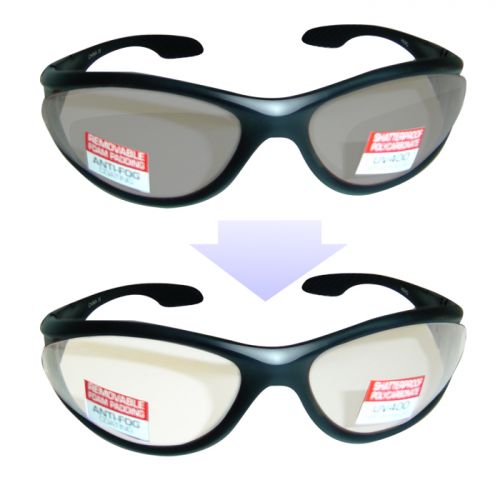Sunglasses or prescription eyeglasses that darken when exposed to the sun were first developed by Corning in the late 1960s and popularized by Transitions in the 1990s. In fact, because of the extreme popularity of the Transitions brand, these lenses are usually referred to as transition lenses. The correct term for these glasses is photochromic or photochromatic, which refers to a specific chemical reaction the lenses have to ultraviolet (UV) radiation.
لماذا تصبح بعض النظارات الطبية معتمة في ضوء الشمس
هل خرجت مع أحد أصدقائك في يوم مشمس واندهشت من تحوّل عدساته الشفافة إلى عدسات شمسية معتمة؟! يطلق على هذه العدسات المستخدمة في هذه النظارات اسم (عدسات فوتوكرومك) والّتي تعني “العدسات المتغيّرة بالضّوء”، اسم آخر شائع لهذه العدسات هو ترانزسشن أو العدسات الانتقالية نسبةً إلى الشركة الرائدة في إنتاج هذه العدسات
Photochromic lenses have millions of molecules of substances such as silver chloride or silver halide embedded in them. The molecules are transparent to visible light in the absence of UV light, which is normal for artificial lighting. But when exposed to UV rays, as in direct sunlight, the molecules undergo a chemical process that causes them to change shape. The new molecular structure absorbs portions of the visible light, causing the lenses to darken. The number of molecules that change shape varies with the intensity of the UV rays.
تحتوي هذه العدسات على بلورات هاليد الفضة (مركب يرتبط فيه الفضة مع أحد الهالوجينات)، وعادة ما يكون كلوريد الفضة. عندما تتعرض هذه البلورات للأشعة فوق البنفسجية الصادرة عن الشمس فإن تركيبها يتغيّر بحيث تصبح داكنة اللون ومعتمة، وتعود للشفافية عند اختفاء مصدر الأشعة فوق البنفسجية. وبما أن إعتام هذه العدسات يعتمد على الأشعة فوق البنفسجية، فإنها تبقى شفافة في المنازل بعيدًا عن ضوء الشمس، كما أنها لا تصبح معتمة عند التعرض للضوء الصناعي، كما أن درجة عتمتها لا تكون كافية في السيارات لأن النوافذ تحجب معظم الأشعة فوق البنفسجية
When you go indoors and out of the UV light, a different chemical reaction takes place. The absence of the UV radiation causes the molecules to "snap back" to their original shape, resulting in the loss of their light absorbing properties. In both directions, the entire process happens very rapidly.
ما يميز هذه العدسات أنها تغني عن حمل نظارات شمسية وطبية، لأنها تؤدي دورهما في آن واحد، كما أنها تحمي العين من الأشعة فوق البنفسجية التي قد تؤدي إلى مرض الماء الأبيض الذي يضعف البصر وقد يؤدي إلى العمى. تتميز هذه العدسات بالقدرة على الإعتام، لكن تغير العدسة من الشفافية إلى العتمة لا يحدث فورًا، حيث أن العدسة قد تستغرق ثلاث دقائق حتى تصبح معتمة. كما أن لدرجة الحرارة تأثير على سرعة عودة العدسات لطبيعتهم الشفافة، حيث أنها تعود للشفافية بسرعة في الجو الحار، على عكس الجو البارد الذي تستغرق فيه وقتًا أطولً
In the original PhotoBrown and PhotoGrey products made by Corning, the lenses are made of glass, and the molecules are distributed evenly throughout the entire lens. The problem with this method was apparent in prescription glasses where different parts of the lens were of varying thickness.
The thicker parts would appear darker than the thinner areas. But with the increasing popularity of plastic lenses, a new method has been developed. By immersing the lenses in a chemical bath, the photochromatic molecules are actually absorbed to a depth of about 150 microns into the plastic. This is much better than a simple coating, which would only be about 5 microns thick and would not provide enough molecules to make the lenses sufficiently dark. This plastic lens absorption process has been popularized by Transitions, the leading manufacturer of photochromic lenses.
An important note about photochromic lenses: because they react to UV light and not to visible light, there are circumstances under which the darkening will not occur. A perfect example of this is in your car. Because the windshield blocks out most UV light, photochromic lenses will not darken. For this reason, most sunglasses with photochromic lenses also have a certain amount of tint already applied to them.
لم تكن العدسات الأولى بتلك الكفاءة، وذلك لأن العدسات الطبية التي تحتوي على كلوريد الفضة حينها كانت مصنوعة من الزجاج، وقد كان كلوريد الفضة موزعًا بالتساوي في العدسة، ولذا فإن درجة العتمة تختلف لاختلاف سمك الزجاج من موضع لآخر في العدسة نفسها. وقد وجد المصنعون الحل لهذه المشكلة بعد انتشار استخدام البلاستيك في صنع العدسات الطبية، حيث تُغمر العدسات البلاستيكية في حمام كيميائي بحيث يُمتص كلوريد الفضة إلى عمق 150 ميكرومتر (1 ميكرومتر = 10-6 متر) من سطح العدسة
Sites: How stuff works, ibda3world



